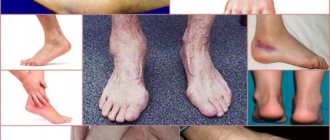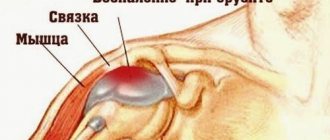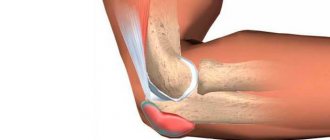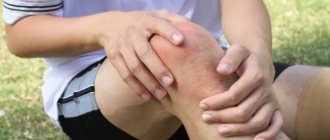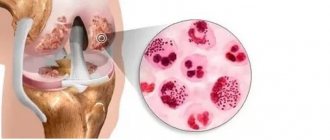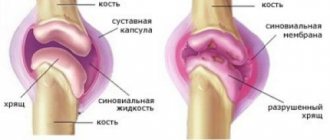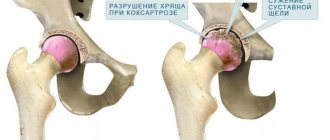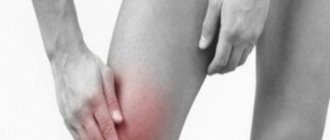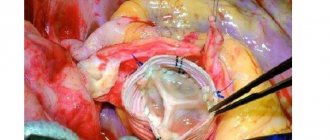Arthritis of the ankle joint has recently become “younger”. This diagnosis is diagnosed equally often in the elderly, young people, and children. The disease has a complex course, can significantly reduce the quality of life and cause a lot of inconvenience to the patient. Therefore, information about the symptoms, causes of development and modern methods of treating ankle arthritis is very relevant. Let's look at how the disease manifests itself at different stages, how to treat ankle arthritis, and what the prognosis for the patient is.
What is ankle arthritis
The musculoskeletal system is responsible for the full movement of a person, therefore it works under conditions of constant load. It is obvious that sometimes individual parts of this apparatus fail, and the lower extremities are especially often injured. Ankle arthritis is considered a common injury.
The term “arthritis” refers to a collection of various lesions of joint tissue. Arthritis can be either an independent disease or a manifestation of pathologies such as gout, rheumatism, psoriasis, and tuberculosis. Therefore, it is classified into types depending on the cause of arthritic joint damage. It occurs in acute or chronic form.
On a note! In medicine, the diagnosis of arthritis of the ankle joint according to the ICD is code 10: pathologies of the musculoskeletal system.
What is ankle arthritis? It is an inflammatory process in the joint caused by injury, autoimmune disorders, infections and metabolic dysfunction. The pathology is accompanied by stiffness of movement of the affected leg, it progresses quickly and, without treatment, ends in disability.
More often, the pathology is diagnosed in old age, but cases of juvenile (childhood) arthritis are not uncommon. Therefore, if characteristic signs appear, an in-person consultation with a doctor is necessary.
Features of the course of acute and chronic forms of arthritis of the ankle joint
The course of ankle arthritis occurs in two forms, each of which has its own clinical picture:
- Acute arthritis of the ankle joint - rapid damage to the joint occurs with pronounced symptoms. The patient notes localized swelling of the ankle, there is pain, and the body temperature in the ankle area rises sharply. If acute purulent arthritis develops against the background of infection, the skin on the leg turns red, fever begins, and health deteriorates greatly.
- The chronic form of arthritis is characterized by regular resumption of general symptoms - heat, redness of the skin, swelling of tissues, pain (usually in the morning).
Arthritis of the ankle joint - photo
Types of Ankle Arthritis
Since arthritis can be caused by various diseases, it is usually divided into several types. Each type has its own development mechanism, symptoms and treatment tactics. A separate category is juvenile arthritis, a pathology that occurs in children.
Rheumatoid arthritis of the ankle
The nature of rheumatoid arthritis is autoimmune in nature. As a result of a malfunction of the immune function, the body begins to destroy joint tissue, considering it a foreign body. The disease occurs in a chronic form, gradually destroying the hyaline cartilage of the ankle, and over time spreads to other joints.
Several factors trigger this pathological mechanism in the joint. It could be:
- Acute infectious disease, for example, influenza, purulent tonsillitis, viral pneumonia.
- Genetic predisposition (there are already cases of rheumatoid arthritis in the family).
- Chronic pathologies of joints of an infectious nature.
- Severe stress or chronic nervous experiences.
- Hormonal changes (typical for women).
At first, rheumatoid arthritis is difficult to differentiate. In the early stages of development, the disease has common symptoms: pain, difficulty with mobility, swelling and tissue hyperthermia. As the pathology progresses, subcutaneous nodules and joint deformation can be noticed.
Considering the autoimmune nature of the disease, treatment for this type of arthritis consists not only of taking anti-inflammatory drugs, but also specific drugs that suppress the immune system (cytostatics, gold preparations). Only an integrated approach can delay the destruction of joint cells by antibodies of the immune system.
Gouty arthritis of the ankle
Gout is a disease caused by a metabolic disorder, which is manifested by a persistent increase in uric acid in the body. As this substance accumulates in the blood, it begins to affect the joints, causing hellish pain and making it difficult to move the ankle.
Uric acid crystals have a fairly dense structure. They begin to accumulate in the joints, destroying cartilage tissue. This leads to the appearance of painful growths (tophi) and the development of chronic gouty arthritis, which is characterized by periods of remission and exacerbation.
To relieve arthritis, the patient undergoes anti-inflammatory therapy aimed at restoring articular cartilage, and also constantly takes special medications to remove uric acid from the body. An important component of therapy is a diet that excludes foods with a high purine content.
Post-traumatic arthritis of the ankle
This type of arthritis is not caused by infections or chronic diseases, but by a specific injury to the ankle. Degeneration of cartilage tissue can occur as a result of tendon rupture, hemorrhage into the joint capsule, damage to the meniscus, cartilage joints or joint capsule.
Ankle injuries are more common among athletes. Also, the risk of developing post-traumatic arthritis is very high in obese people.
After an injury, the patient may notice only minor symptoms - pain, redness, swelling. They may go away without treatment, but in the future there will be a gradual decrease in the performance of the damaged ankle. For this reason, all injuries, even minor ones, should be treated professionally.
Suppurative arthritis of the ankle joint
Purulent arthritis is the name given to arthritis that develops as a result of infection entering the joint and subsequent suppuration. Without timely antibiotic therapy, the purulent process spreads to adjacent tissues and quickly damages nearby joints. A common cause of joint infection is HIV, hematomas in the joint.
Symptoms of purulent arthritis include high body temperature, severe swelling and pain in the ankle. Without the prescription of a strong antibiotic, the cartilage is quickly affected by pus and destroyed.
Reactive arthritis of the ankle
Arthritis is caused by damage to cartilage by pathogenic flora. The culprits may be:
- urogenital pathogens (chlamydia, ureaplasma);
- intestinal flora (Escherichia coli, Shigella, Salmonella);
- coccal microbes (pneumococcus, streptococcus, tuberculosis bacillus);
- Coxsackie virus, influenza.
Reactive arthritis is manifested by an increase in temperature above 37.8⁰C, poor range of joint mobility, intoxication, and inflammation of tissue fibers. Regional enlargement of lymph nodes, deterioration of heart function, and pleurisy may be observed.
Treatment is carried out with antibiotics, painkillers and anti-inflammatory drugs. It is equally important to undergo physical therapy to restore ankle mobility.
Juvenile arthritis of the ankle
Arthritis of the ankle joint in a child can occur for the same reasons as in adulthood. The causes of the disease are the same - autoimmune dysfunction, infections, various injuries. But there are a number of factors that provoke arthritis only in children. These include:
- Vaccination - if the vaccine is administered to an unhealthy baby, acute infectious arthritis may develop.
- Hypothermia or prolonged insolation - in childhood, the influence of borderline temperature values can cause arthritis.
The danger of juvenile arthritis is that the disease can occur latently in a chronic form. The child has no other signs other than minor irregular pain in the ankle. The process of cartilage destruction goes unnoticed, and further treatment will be difficult and lengthy.
Arthritis of the ankle joint - causes
Each type of arthritis has its own causes. For example, gouty arthritis is caused by gout, purulent arthritis is caused by infection, and post-traumatic arthritis is caused by injury. There are the following eight causes of arthritis:
- Pathogenic microflora (gonococci, chlamydia, pneumococci, etc.).
- Metabolic dysfunction.
- Urogenital pathologies.
- Ankle injuries, wearing uncomfortable shoes.
- Obesity.
- Genetic predisposition.
- Autoimmune diseases.
- Sports activity.
Causes of the disease
Arthritis of the ankle develops both in childhood and in adulthood. In children, acute respiratory and intestinal infections and allergies become development factors. The disease can appear when a person wears uncomfortable shoes, is obese, has bad habits and lives in an unfavorable environment where sanitary standards are violated. Some athletes are also affected, such as hockey players and figure skaters. Ankle arthritis occurs due to:
- the appearance of systemic lupus erythematosus;
- gout;
- arthrosis;
- mechanical joint damage, such as sprain, rupture, etc.;
- impaired metabolic processes;
- previously suffered infectious diseases affecting the urinary, reproductive, digestive system and ENT organs;
- spread of inflammation to the tissues surrounding the ankle joint;
- hereditary predisposition;
- weak immunity;
- hormonal imbalances;
- frequent hypothermia of the body.
Ankle arthritis: symptoms
Knowing the symptoms of ankle arthritis allows you to notice the problem in time and begin adequate treatment, which will preserve the articular cartilage.
Common signs of ankle arthritis:
- The skin around the joint turns red, and a local increase in temperature occurs.
- The ankle swells noticeably and the skin stretches.
- When the joint moves, severe pain occurs.
- It becomes difficult to wear your usual shoes - they are uncomfortable, they pinch and rub.
- Joint atrophy is observed.
- The inflammatory process progresses, mobility decreases sharply.
- There is a gradual increase in pain syndrome.
- There may be a general deterioration in health: fatigue, lethargy, nausea, fever.
Important! The specific symptoms of ankle arthritis depend primarily on the nature of the inflammation. Thus, gouty arthritis is characterized by the appearance of growths on the joint and a sharp limitation of mobility at the peak of an exacerbation, while reactive arthritis is characterized by severe intoxication and the presence of pus in the joint.
Manifestations and diagnosis
Let's start with the main thing: any arthritis of the ankle joint always affects its function. This means that walking becomes uncomfortable, painful, and sometimes impossible. The main symptoms are pain and swelling. Joint deformity occurs in the long term and is not typical for the initial stages.
The main task is to identify the cause in time. Most diseases that lead to ankle inflammation can be cured completely and significantly affect the progression of others.
Due to a variety of reasons, the task is not easy. It is necessary to use almost the entire arsenal of diagnostic techniques. We list the main ones that have the greatest diagnostic value:
- A thorough medical examination and interview. Allows you to determine the degree of progression of the disease and suspect the probable cause. It is a determining factor for further diagnosis.
- Clinical tests of blood and urine. Identify signs of a general inflammatory reaction.
- Biochemical blood parameters. They will be especially useful for crystalline arthritis.
- Serological studies. Designed to identify the causes of arthritis associated with infection.
- X-ray, CT, MRI. They provide valuable data on the anatomical structure of the joint and its changes. First of all, the condition of the interarticular space is assessed.
There is a high probability of making a diagnostic error if you do not take into account the complex condition of the whole organism and look only at the symptoms of the ankle joint. An inaccurate diagnosis leads to ineffective treatment, dysfunction of the joint, and even disability.
Before starting to treat the pain, swelling, and dysfunction that accompany arthritis of the ankle joint, it is imperative that a full examination and competent analysis of the data obtained is necessary.
Methods for diagnosing ankle arthritis
Arthritis can be easily confused with other pathologies of the ankle joint, for example, arthrosis, so a number of diagnostic studies are carried out to clarify the diagnosis:
- UAC, OAM. Blood and urine testing is necessary to determine inflammation, rheumatic factor indicators, and concomitant disorders.
- Ultrasound allows you to assess the degree of cartilage destruction, the presence/absence of a purulent sac, hematomas, and tendon damage.
- Determination of antibodies to the causative agent of arthritis (rheumatoid factor). Carry out if the autoimmune nature of the disease is suspected.
- X-ray, CT, MRI - at the doctor’s choice, one of these studies is performed to clarify the extent of damage to the joint.
- Arthroscopy - the procedure involves inserting an optical device into the joint capsule. In this way, they not only clarify the diagnosis, but also remove fluid or blood.
Arthritis of the ankle joint - treatment
Depending on the form of arthritis, the doctor draws up a treatment regimen, the success of which directly depends on the implementation of medical recommendations. These include:
- Taking painkillers.
- Antibiotic therapy (if the cause of arthritis is infection).
- Undergoing anti-inflammatory treatment.
- Rehabilitation therapy (physical therapy, massage, diet).
Arthritis of the ankle joint - conservative therapy
Treatment of ankle arthritis at home involves conservative methods. Treatment tactics are always compiled individually, since the complex of drugs is selected taking into account the severity of arthritis. As a rule, the patient has to take anti-inflammatory drugs, analgesics, immunomodulators, and in some cases hormones and antibiotics.
Important! All medications for the relief of ankle arthritis are taken only as prescribed by a doctor. Self-medication can cause complications in the form of complete destruction of cartilage.
The patient may be prescribed the following groups of drugs - NSAIDs, corticosteroids, antibiotics, chondroprotectors.
- NSAIDs are taken to eliminate signs of inflammation - pain, heat, swelling. These may be medications based on diclofenac sodium (Dicloberl, Naklofen) or ibuprofen (Nurofen, Imet). They perfectly reduce body temperature and relieve pain. Can be taken within 10-14 days. Oral administration of tablets and intramuscular administration are allowed. The use of ointments for arthritis of the ankle joint based on NSAIDs - Voltaren, DIP-relief, Ortofen, Fastum-gel - is effective.
- Corticosteroids are hormonal drugs that are indicated in case of ineffectiveness of NSAIDs. The patient can be prescribed Prednisolone, it has an antiallergic and restorative effect. Betamethasone is also used, it relieves itching, swelling and stiffness of movement.
- Antibiotics are necessary when it comes to reactive arthritis. Levomycetin, Tetracycline and other groups of antibiotics may be prescribed. The choice depends on the causative agent of arthritis.
- Chondroprotectors are prescribed to maintain damaged cartilage. Teraflex and Movex Active capsules are effective. The drugs stimulate collagen synthesis and allow the restoration of cartilage tissue.
Arthritis of the ankle joint - surgical intervention
Surgery may be necessary if irreversible joint deformation, ankylosis, or formations in the joint cavity occur that need to be removed.
Surgical methods include:
- Arthroscopy with subsequent drainage is performed to remove purulent exudate and hemorrhage. A drainage instrument is inserted into the joint through the incision and the fluid is pumped out.
- Arthrodesis is the mechanical fusion of individual areas of the ankle in order to prevent further destruction of the joint and restore its mobility.
- Synovectomy - remove damaged tissues, pump out purulent exudate.
- Endoprosthetics - removal and subsequent replacement of a joint.
Massage for ankle arthritis
Massage has been used successfully in the treatment of arthritis. The procedure disperses lymph and improves motor activity. It should be noted that massage sessions are carried out only during the period of remission and only as prescribed by the doctor. Before the procedure, the doctor examines the patient. Only a master performs massage using approved massage techniques. Self-massage is not recommended for arthritis.
Exercise therapy for ankle arthritis
Arthritis results in limited mobility and impaired blood flow, so it is advisable to undergo physical therapy. A number of exercises can not only improve joint mobility, but also reduce pain, swelling, and numbness.
A set of exercises for ankle arthritis is selected individually. Some exercises can be done at home, others in a physical therapy room under the supervision of a rehabilitation therapist. A typical set of exercises consists of different types of walking, foot rolls, and jumping.
Exercises for ankle arthritis, photo
How to treat ankle arthritis, all treatment methods
Treatment depends entirely on the form of the disease, the stage of its progression, symptoms and signs. It is important to stop the inflammatory process and eliminate the root cause that triggered the development of arthritis.
First of all, you need to give the joint complete rest and minimize any stress on it. Doctors recommend using a cane when walking to relieve some of the stress.
Bed rest, immobilization of the joint and application of an elastic bandage are recommended. Treatment of arthritis is complex with the prescription of medications, painkillers, chondroprotectors, and physiotherapy.
Diet, gymnastics, massage, local treatment by rubbing ointments and gels into the joint, applying lotions to relieve pain and swelling are indicated. Attention! Only the doctor prescribes treatment.
Self-medication can become not only ineffective, but also dangerous, only complicate the situation, and lead to irreversible degenerative consequences. At the first suspicion of arthritis, you should go to the emergency room.
It is important to apply a cast or other fixing bandage in a timely manner, to reduce the load on the joint, so that in addition to the inflammatory process occurring in it, you do not aggravate the situation by placing stress on the joint, which only accompanies the appearance of cracks and accelerating the destruction of the articular cavity.
1) Medicines are prescribed by a doctor only when a final diagnosis is made based on the results of examinations: ultrasound, x-ray, MRI.
To relieve inflammation, pain and swelling, anti-inflammatory, non-steroidal drugs are used: Ibuprofen, Ketaprofen, Aspirin.
Diet for ankle arthritis
To ensure that the joint tissue can fully recover, the patient is prescribed a diet.
The diet should consist of foods containing vitamins:
- B1 (legumes, whole grain bread, baked potatoes);
- B2 (fermented milk drinks, eggs, tomatoes, offal);
- B6 (chicken, all types of cabbage, nut kernels, cereals, citrus fruits);
- B12 (seafood, rabbit, lean beef).
General nutritional recommendations:
- Eating food 4-6 times in small portions.
- Refusal to eat after 18-00.
- Avoid alcohol and caffeine.
- Drinking regimen (at least 2 liters of water).
Arthritis of the ankle joint: treatment with folk remedies
After consultation with the doctor, the use of folk remedies is allowed:
- Alcohol rub: 250 ml of alcohol and 25 g of bear's ear inflorescences are infused for 14 days. Used to rub the ankle twice a day.
- Herbal tincture: pour 20 g of woodlice into a glass of boiling water, leave in a thermos for 60 minutes. Take ¼ cup before meals 3-4 times a day.
- Pain-relieving compress: dissolve 30 g of sea salt in heated water, soak gauze in the liquid and apply to the ankle. The procedure is carried out daily (no longer than 20 days).
Important! Traditional treatment of ankle arthritis is only an auxiliary measure and does not exclude the need for conservative therapy.
It is much easier to prevent arthritis than to treat it. To avoid illness, follow a balanced diet, increase the amount of time you spend in the fresh air and do not neglect basic physical exercise.
How to cure with traditional methods?
Today dietary supplements are applicable and approved by doctors.
For example, collagen ultra has a number of benefits:
- Has a beneficial effect on the joint;
- Eliminates pain;
- Relieves inflammation;
- Reduces swelling;
- Accelerates regeneration processes in the articular cavity;
- Restores cartilage and all bone structures, nourishing them with amino acids and protein in the composition.
You can prepare a decoction at home. Pour boiling water (1 glass) over elderberry leaves (3 tsp dry), leave in a water bath for up to 20 minutes, cool, drink in sips up to 8 times a day.
It is also good to brew and take corn silk, birch buds, and black currant leaves regularly.


